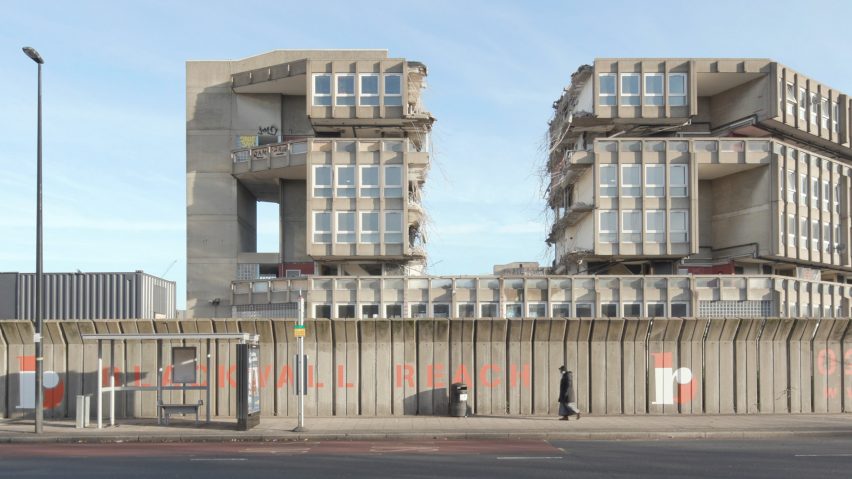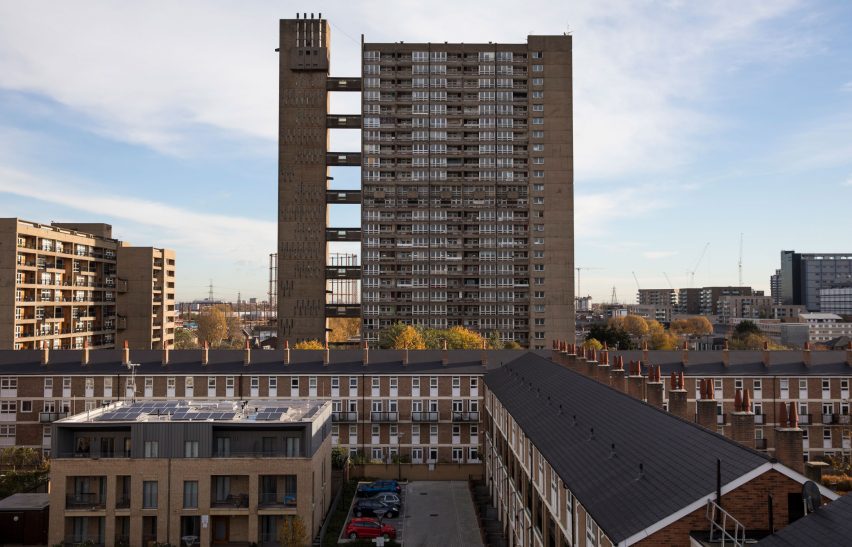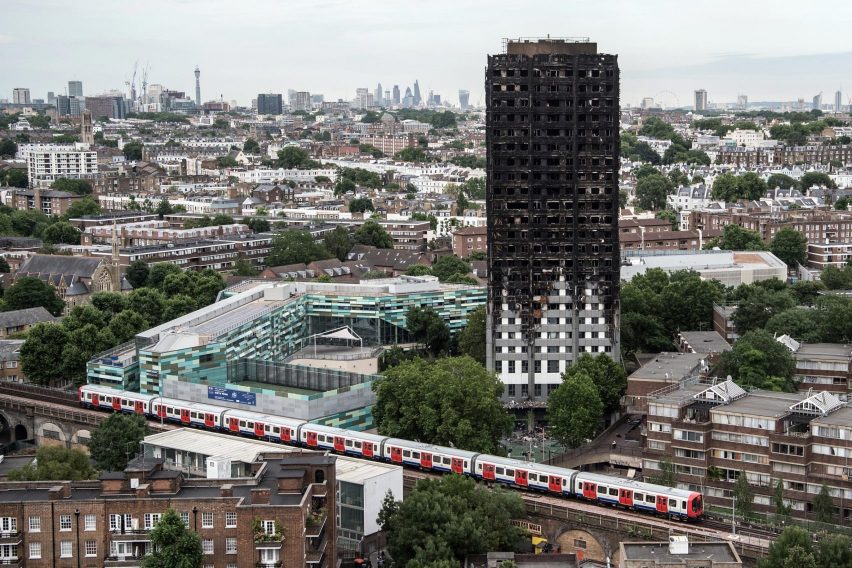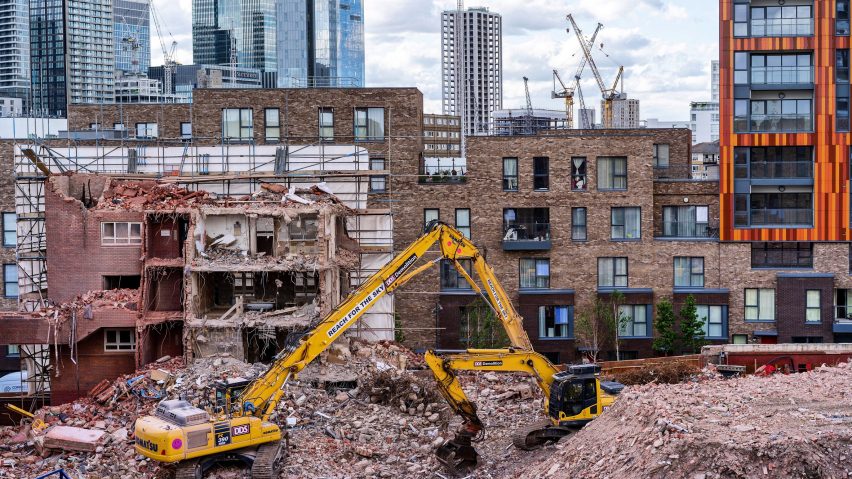
Demolition of council estates "has peaked"
For our Social Housing Revival series, we look at how the fate of UK social-housing estates has become an urgent topic as councils grapple with the housing crisis and challenges of preservation.
Regeneration of social housing estates – which typically involves demolishing post-war estates and replacing them with new housing that increases the overall number of units but reduces the proportion of social-rent homes – has become a highly contentious issue in Britain.
Nearly 60,000 social-rented homes have been bulldozed in England over the last 10 years, while in London alone 101 estates are reportedly still under threat.
Social housing "has been decimated"
Politicians, councils and housing associations undertaking regeneration projects argue that they are an effective way of increasing overall housing supply while improving living conditions for tenants.
But regeneration schemes are often highly controversial, with some opponents claiming they can amount to social cleansing as long-standing residents are moved elsewhere.
Anti-demolition campaigns have frequently drawn the attention of the architecture community – most notably the unsuccessful attempts to save Robin Hood Gardens in east London, razed in 2017.

Now, as concerns about the UK's housing-affordability crisis continue to grow, author and journalist Anna Minton believes changing public sentiment about social housing may be turning the tide against further estate regeneration.
"The stock has been decimated and people would love to live in it," said Minton, a vocal critic of estate regeneration. "I think it's lost its bad reputation – people think, 'if only houses were available on council estates in the way they used to be'."
"There is a renewed interest because affordable housing and the housing crisis is right at the top of the political agenda in a way that it wasn't before," she told Dezeen. "This big push on estate regeneration – I think it has kind of peaked."
Eamon McGoldrick, the managing director of trade body National Federation of ALMOs – council-housing management companies – added that local authorities may be less inclined to demolish social housing as they spend increasingly large portions of their budgets responding to rising homelessness.
"Lots of councils have got long homelessness queues, they've all got waiting lists," he told Dezeen.
"If we knock [an estate] down, we lose those 200 units or 500 units while we replace them, and that could mean a lot of people in temporary accommodation while the new homes are built," he added. "That could be five or 10 years apart."
"Mixed bag of feelings" over council estates
Among those fighting to preserve council estates is architectural charity the Twentieth Century Society, whose list of at-risk buildings includes the Alton Estate in southwest London and Central Hill in Lambeth, London.
Like Minton, the charity's director, Catherine Croft, believes that people are increasingly seeing the value in existing council estates.
"I think people often have a real mixed bag of feelings about this," she told Dezeen.
"In a lot of cases, they're very aware that [the buildings] haven't been invested in, that they haven't had the maintenance that they deserve, and they can feel incredibly frustrated about that, and forgotten and neglected."

"But I think they're often really appreciative of the space standards – particularly of the post-1960s, '70s and '80s housing, which have large living areas, plenty of storage and often balconies," she added.
"And often the public areas of those estates were designed incredibly carefully to provide pleasant settings for the building and fun places for recreation."
"Lots of design faults" in post-war housing
However, that's not the case for every estate. There have been particular concerns over estates constructed using large-panel systems (LPS).
LPS construction, which has been likened to a concrete house of cards, first came under the spotlight after the 1968 Ronan Point disaster in east London, where the partial collapse of the recently built tower block killed four people.
"The main problem for local authorities is there was massive council house-building in the 1960s and '70s and a lot of it was high density – quite a lot of it was concrete, large-panel system construction," McGoldrick said.
"I think, to be honest, there were a lot of design faults in them – I think that is accepted, especially with the large-panel system."
In many cases, the construction of LPS buildings led to damp and mould problems inside flats. In cash-strapped councils, these problems got worse over time due to a lack of maintenance.
"Some of the workmanship wasn't very good, sometimes the bolts weren't connected – also, inherently, they were great big lumps of concrete, and they get cold," McGoldrick added.
Grenfell put spotlight on council estate maintenance
And while the argument for renovation over demolition has been made more strongly in recent years, the retention of council housing hasn't always been without issues.
A recent example is the Balfron Tower in Poplar, east London, designed by architect Ernö Goldfinger and built in 1967.
Housing association Poplar Harca formed a joint venture with developers Telford Homes and Londonewcastle to renovate the tower in a project that involved council tenants being moved out of the building and not allowed to return. Flats in the building were put on the market in 2019 but as of August of last year, none had been sold.

Meanwhile, at Grenfell Tower in North Kensington, the Royal Borough of Kensington and Chelsea decided to invest in refurbishing the existing building and keep it as council housing to disastrous effect.
In June 2017, a fire at the block killed 72 people after spreading rapidly across cladding that had been installed as part of upgrades intended to improve the building's thermal efficiency.
"The Grenfell tragedy was born through, 'this is a cold tower block, heating bills are high, so let's clad it in insulation," McGoldrick said. "The idea was fantastic, the execution of the works and the products obviously wasn't."
However, Minton argues that the Grenfell disaster has since had an impact on changing people's views of council estates.
"When the tower burnt down, for the first few weeks or so, the media was saying this was a ghetto, a terrible council block – and there was just a complete backlash; people were saying 'it wasn't like that at all, it was a genuinely mixed community that people loved living in'," she said.
"It shone a light on what it was really like, rather than the narrative that is so often painted by the media."
Regeneration "shouldn't be a dirty word'
The picture also varies considerably across the country. Kevin Garvey, South West regional lead at housing-association trade body the National Housing Federation, argues that there are areas where regeneration can be a valuable tool in boosting local economies.
"Regeneration has a really important role to play in different parts of the country and it shouldn't necessarily be a dirty word," he told Dezeen.
"There's absolutely an argument there for the sector to be looking at regeneration as a particular avenue, particularly where the cost of dealing with those homes – hard-to-retrofit homes, hard-to-treat homes – where the cost of doing that actually exceeds the value of a particular home as an asset."
The key, he says, is ensuring that the interests of the people living in the affected homes are properly taken into account.
"Acting in the interest of the business and acting in the interests of the people that live in these homes, that needs to be weighed up and considered as part of the process around regeneration," Garvey said.
Changing financial picture
Social landlords often claim that tearing down and rebuilding ageing estates is cheaper than the cost of renovation. Funding for social housing is in perennially short supply, something that Croft says has to be taken into account when considering whether to demolish or retain.
"It is hard to find the money, not just for renovation and restoration projects, but perhaps even more critically for ongoing maintenance," Croft said. "That's so unglamorous but absolutely critical."
But here too, the situation may be changing. One major cost of regeneration is purchasing homes set to be demolished from home-owners on the estate.
There have been infamous examples of people being forced to sell their homes for paltry sums and consequently having to move far out of the area – most notably at the Heygate Estate in Southwark.
Following a landmark ruling affecting the nearby Aylesbury Estate, social landlords are now required to pay more.
"There have been some very high-profile public inquiries," said Minton. "When it becomes clear that residents homeowners will fight councils and will have to get a lot more in compulsory purchase, it stops making so much financial sense for councils."

Then there is the debate over sustainability. As the building industry increasingly focuses on issues around embodied carbon, retaining existing buildings has become a priority.
Under updated planning guidance published by London mayor Sadiq Khan, large projects in the city will have to meet embodied carbon benchmarks and prioritise retaining existing buildings over demolition.
"It's absolutely something that housing associations factor into their thinking – we can't talk about a net zero economy and net zero on decarbonizing the home, without thinking about that embodied carbon aspect to any regeneration that takes place," Garvey said.
Advances in building technology can also make upgrading existing buildings more effective. The Twentieth Century Society, for example, has been working with a new window solution for the Golden Lane Estate in the City of London, putting in vacuum glazing rather than double glazing to help insulation.
"It's a much narrower sandwich and that means it's much easier to fit into existing window frames," Croft said.
Regardless of politics, practical considerations like these could mean under-threat estates are safe for some time yet.
The main photo is by Dezeen.

Social Housing Revival
This article is part of Dezeen's Social Housing Revival series exploring the new wave of quality social housing being built around the world, and asking whether a return to social house-building at scale can help solve affordability issues and homelessness in our major cities.